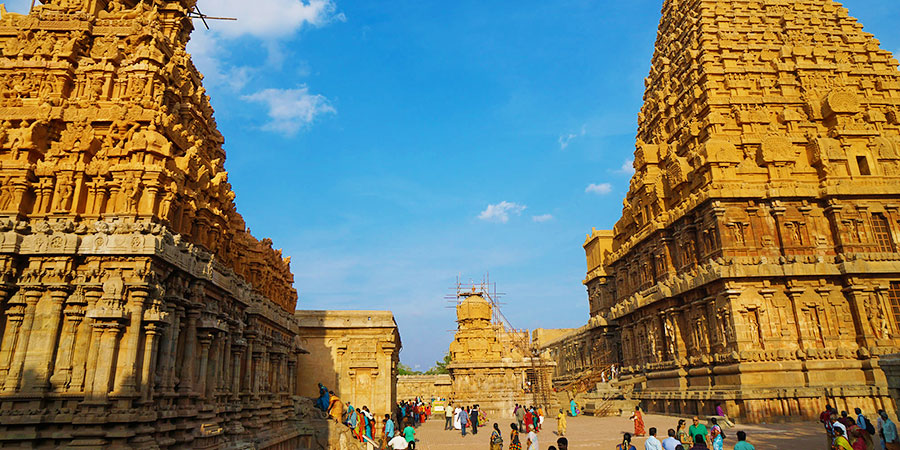Brihadeeswara Shiva Temple, Tanjore - Fascinating Temple of the Chola Dynasty
Located in the Tanjore district of the state of Tamil Nadu, the Tanjore city is well known all across the globe for its classic paintings. Also referred to as Tanjavur, this charismatic city is about 10km (6.2mi) away from River Kaveri. Art lovers from across the country and the globe have appreciated the art, music and handicrafts of the place which reflects the rich cultural heritage. There is a legend behind the name of this city.The myth around the city
The legend goes that when the rage and the fury of the Tanjan demon became intolerable, he was put to death by Sri Neelamegapperumal and Sri Anandavali Amman. But, the demon was granted with his last wish where he wanted to name the city after him and hence the city came to known as Tanjore. History says, from the 10th century to the 14th century, Tanjavor remained the capital city of the Chola Empire. It is during this period when many architecturally significant temples were built (more than 74 beautiful temples). Today, the place is a significant pilgrimage site for the Hindus.

Brihadeeswara Shiva Temple
|
Brihadeeswara Shiva Temple, Tanjore
One of the most fascinating temples of South India is Brihadeshwara Temple which is declared as the 'World Heritage Site' by UNESCO. Its exemplary architecture is a great witness to the creativity of the Chola Dynasty. Raja Chola laid the foundation of the temple in the 10th century and was dedicated to Lord Shiva. The Shiv Lingam is beautifully carved out of a single rock. The towering Gopuram (200 ft) and the top cupola (which is about 81 tons) are the two most notable features of the temple.Did you know the temple never casts a shadow in the afternoon?
More about the Brihadeeswara Shiva Temple, Tanjore
Constructed in the period of 995 AD and 1025 CE, the Brihadishvara (or Brhadisvara) temple sometimes referred to as the Rajarajeshvara (after the Chola king who built it). Historical records point out, the temple was built with the war bounty and tributes received by the Chola emperors.Interestingly, it is one of the tallest temple buildings in India reaching to a towering height of 63 metres. Dedicated to the Shiva (an important god in the Hindu pantheon), the temple has a rectangular complex measuring around 140 by 75 metres. Apart from that, the regular interior slots surround the walls. Several secondary shrines and a massive double gateway entrance (gopuras) which is a signature part of the construction could also be found here.
Structure

|
The Dravida architecture of southern India has a special design known as padmagarbhamandala where the foundation is laid on a precise plan of 16 x 16 squares. In this structure, the interior contains the archetypal passageway for visitors that lead them circumambulation passage. Interestingly, for this temple, the passage is in two levels. The 4-metre tall Shiva linga (phallus) is contained in the garbhagriha which is the main deity. The ritualistic bathing of the god, placed within a portico (ardhamandapa), is performed at the snapana platform.
You can find the fascinating murals that are embellished in the interior walls.
Did you know these murals were once hidden by later Nayaka period paintings? Some of the murals contained images of Rajaraja I and his guru or spiritual advisor, and the beautiful picture of his three queens.
One of the most prominent murals is that of Nataraja (Shiva as Lord of the Dance) whom the Cholas considered as their clan deity (kuladevata).
The sculptures of the temple

Sculptures of Brihadeeswara Shiva Temple
|
The Gopuras
The two huge monumental gateways in the Brihadeeswara Shiva Temple, Tanjore would lead you to the main site. They are the earliest mature models of the form in southern India. Each façade (interior and exterior) are unique in their own way because the gopuras at Thanjavur are not identical as found in the later examples. There are two large dvarapalas (door guardians) on the outer facades as well as a figurine sculptures.How to reach
By air
The nearest airport to Brihadeeshwar Temple is the Tiruchirapalli Airport which is about 65 km (40 mi).By rail
The nearest railhead to this temple is Thanjavur.By road
Thanjavur is a popular tourist city and can be easily accessed from the neighbouring cities through a bus. You can book the government and private buses running to Thanjavur throughout the day in good frequency.Timings
6:00 a.m. – 12:30 noon, 4:00 p.m. – 8:30 p.m.
Other popular attractions in Tanjore: Saraswathi Mahal Library, Tanjore Art Gallery, Thanjavur Maratha Palace

